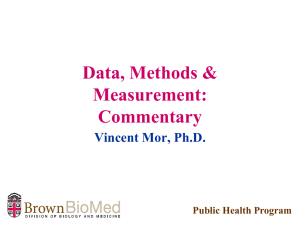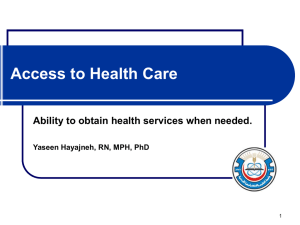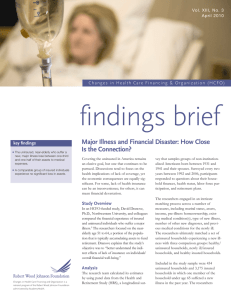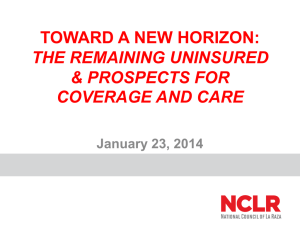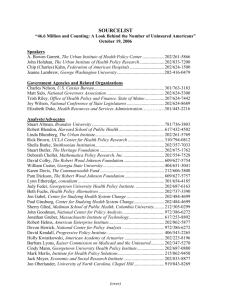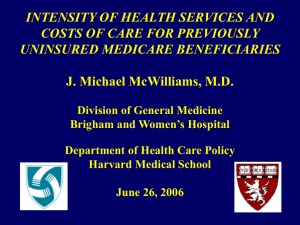Does Major Illness Cause Financial Catastrophe? Northwestern University
advertisement
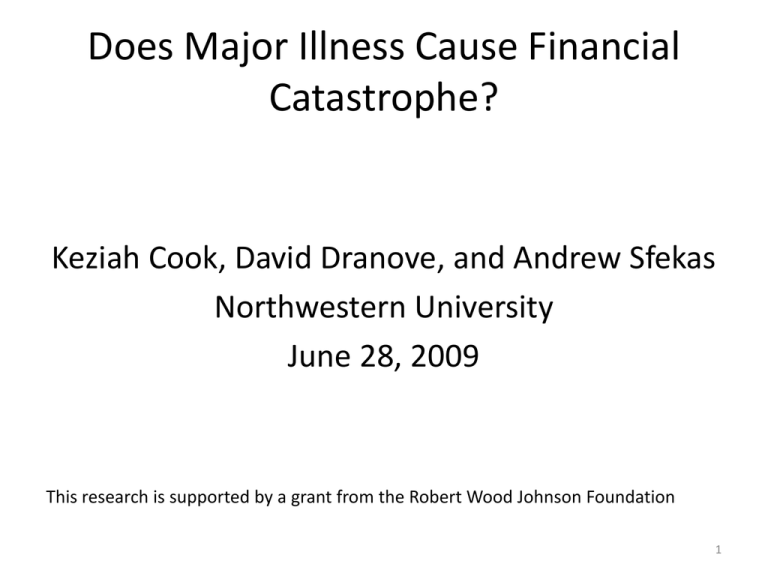
Does Major Illness Cause Financial Catastrophe? Keziah Cook, David Dranove, and Andrew Sfekas Northwestern University June 28, 2009 This research is supported by a grant from the Robert Wood Johnson Foundation 1 Stormy Beginnings • Origin of paper may be traced to article by Himmelstein et al. in Health Affairs on “medical bankruptcy” – Source of the oft-repeated claim that 50+% of bankruptcies are due to medical reasons – Additional claim that private insurance coverage cannot avert bankruptcies – Methods were severely criticized • Dranove and Millenson published a lengthy critique – Described methodological flaws and proposed alternative methodology – My time was partially funded by AHIP – I was allegedly “in bed” with industry • Honorable course of action: Do the work correctly 2 Research Plan • Necessary bankruptcy data not readily available • Data on financial assets is readily available – This is more relevant – Bankruptcy is a “good event” after many bad ones • Ask whether uninsured suffer financial losses after a major illness – Compare with losses suffered by insured individuals with same conditions – Compare with trends in wealth accumulation for those uninsured who remain healthy – Triple difference analysis 3 Focus on Near Elderly • Those over 65 protected by Medicare • Very young have few assets to protect • Pragmatically, our data is from the Health and Retirement Survey – Survey respondents are all near elderly 4 Previous Literature-Bankruptcy • Himmelstein et al. (2005) survey individuals who filed for bankruptcy and associate with “medical” factors including injury, childbirth, and medical spending over $1000 • Fay, Hurst, and White (2002) find no link between illness and bankruptcy • Domowitz and Sartain (1999) find that medical debt is a cause of bankruptcy, but that few households have high medical debt • Gross and Souletes (2002) find no link between insurance coverage (measured at state level) and bankruptcy 5 Previous Literature – Health and Wealth • Wu (2003) finds that wife’s health affects household wealth • Hurd and Kapteyn (2001) show inverse correlation between health and wealth changes • Smith (1999) uses HRS and finds decline in wealth of $17,000 for new illnesses, unrelated to insurance • Levy (2002) uses HRS and finds new illness has large but statistically insignificant effect on wealth, again unrelated to insurance – Very large standard errors due to skewness of wealth and wealth change 6 HRS • Longitudinal survey of individuals over age 50 • Original cohort in 1992; additional cohorts added beginning in 1998 • Individuals surveyed every two years • Detailed information on household assets and income • Information on major medical conditions and insurance status 7 Experimental Group • Under age 65 • Developed one of six conditions after first interview – Cancer, Heart Disease, Stroke, Diabetes, Lung Disease, Psychiatric Problems – All six are associated with substantial expenditures • Insurance status does not change in periods surrounding incidence of disease • Total size of “newly ill, uninsured” group is 192 8 Matched Groups • We are examining both level and percentage changes in wealth – Percentage changes sensitive to baseline values – Levels and percentage changes sensitive to nonlinearities in process determining changes – Address by matching controls to the 192 experiments • Match on observables – Obtain the effect of the treatment on the treated – i.e., Effect of being uninsured on the currently uninsured households – Assume that we account for all differences in groups that would account for differences in asset accumulation 9 Matching Methods • Exact match on several characteristics – – – – – New disease (for the newly ill group) # of other new diseases Marital status Home ownership Presence of preexisting conditions for self/spouse • Within 50% on: – Lagged assets – Lagged income • One match per newly ill/uninsured in three other categories – Newly ill/insured – Healthy uninsured – Healthy insured 10 Matching continued • Match assets and income using Mahalanobis distance – We keep the household in each group that is closest to the newly ill uninsured household. • An alternative method is propensity-score matching – Heckman et al. (1998) show that when the propensity score must be estimated, the coefficient estimates become less precise. – Exact matching combined with Mahalanobis distance matching allows us to avoid making functional form assumptions on how the matching variables predict the probability of being uninsured. 11 DD and 3D Analysis • DD compares changes in assets of the newly ill uninsured group vs. matched sample of newly ill insured – Matching accounts for differences in starting points – DD allows for differing trajectories of insured and uninsured – E.g., if newly ill insured have -5% change in wealth and newly ill uninsured have -45% change, DD estimate is -40% • 3D acknowledges that there are two treatments – New illness – Uninsured – Computes trajectory of wealth of healthy uninsured versus healthy insured. Say this is 5% versus 15%. Relative trajectory is -10%. – Subtract this relatively trajectory from the DD estimate – E.g., 3D estimate is -40- (-10) = -30% 12 Regression Issues • Measures of asset growth are highly dispersed – OLS generates very large coefficients and very large standard errors – Highly sensitive to extreme outliers • Median regression minimizes these problems • Mostly examine percentage changes in wealth • Focus on individuals of “moderate” baseline wealth – Expect very poor to receive charity care – Very wealthy expend smaller percentage of wealth 13 Table 1: Sample Statistics Before and After Matching # of Households Pre-illness Assets Mean Pre-illness Assets Median Pre-illness Income Mean Pre-illness Income Median % Non-White % w some college % unmarried % pre-existing cond % who own home 25th-percentile 50th-percentile 75th-percentile 90th-percentile Un, Sick 454 Prior to Matching Un, H Ins, S 3810 3175 Ins, H 22197 $101,188 $144,388 $198,261 $11,078 $20,144 $35,523 $23,552 26% 31% 38% 52% 71% -96% -41% 35% 410% Un, S 304 After Matching Un, H Ins, S 304 304 Ins, H 304 $228,789 $107,904 $109,551 $103,545 $108,302 $65,672 $83,111 $14,267 $14,635 $13,730 $14,230 $45,988 $72,678 $75,489 $42,433 $41,837 $42,905 $42,493 $30,239 27% 36% 36% 45% 73% -76% -19% 83% 406% $58,748 18% 54% 25% 56% 86% -57% -6% 73% 281% $60,167 19% 57% 32% 47% 87% -48% 1% 81% 297% $31,185 27% 33% 37% 50% 78% -92% -37% 57% 436% $31,084 27% 35% 37% 50% 78% -76% -8% 110% 432% $31,104 27% 39% 37% 50% 78% -71% -6% 105% 487% $31,487 24% 35% 38% 51% 78% -67% -17% 98% 402% All income and asset values are in 2006 dollars. 14 Table 2: DD and 3D results, All New Diagnoses Initial Assets above: Initial Assets below: DD results uninsured initial income (in $1,000s) hh_nonwhite hh_college Unmarried Pre-existing condition Non-homeowner Constant 3D results N uninsured New-illness-uninsured New-illness initial income (in $1,000s) hh_nonwhite hh_college Unmarried Pre-existing condition Non-homeowner Constant N Asset Change (in $1000s) $1k $0 $200k $3000k -4.176** -2.964* (1.486) (1.238) 0.030 -0.043* (0.031) (0.019) -1.233 -0.659 (1.661) (1.410) 1.336 1.718 (1.706) (1.417) -2.756 -2.943* (1.762) (1.465) 0.612 0.954 (1.550) (1.282) -0.003 1.193 (1.840) (1.568) 1.031 1.329 (2.541) (2.081) 484 608 -0.218 -0.165 (1.304) (1.205) -4.240* -3.006+ (1.830) (1.692) 1.660 0.940 (1.289) (1.196) 0.059** 0.022+ (0.019) (0.013) -1.679 -0.872 (1.066) (0.998) 2.534* 1.206 (1.064) (0.973) -0.631 -1.011 (1.112) (1.023) 0.018 -0.032 (0.982) (0.896) -0.165 0.179 (1.173) (1.099) -1.990 -0.494 (1.748) (1.545) 968 1216 % Asset Change $1k $0 $200k $3000k -0.460** -0.336** (0.160) (0.124) 0.001 0.000 (0.003) (0.002) -0.293 -0.145 (0.178) (0.142) 0.187 0.175 (0.183) (0.141) -0.443* -0.479** (0.189) (0.145) -0.085 -0.142 (0.167) (0.128) -0.034 -0.058 (0.199) (0.158) 0.157 0.163 (0.274) (0.205) 484 608 0.078 0.023 (0.137) (0.107) -0.538** -0.333* (0.192) (0.150) 0.240+ 0.117 (0.136) (0.107) 0.005* 0.001 (0.002) (0.001) -0.272* -0.217* (0.112) (0.089) 0.195+ 0.212* (0.111) (0.086) -0.202+ -0.292** (0.116) (0.091) -0.143 -0.147+ (0.103) (0.080) -0.159 -0.147 (0.123) (0.099) -0.153 -0.011 (0.183) (0.137) 968 1216 15 Conclusions • It stinks to be uninsured and get sick – An uninsured individual who has a major illness loses 30-50% of lifetime asset accumulation relative to insured person who gets sick • The insured who fall ill do not suffer a reduction in wealth – Point estimate of wealth change is positive 16 Reentering the Fray • There is substantial evidence that uninsured Americans are one illness away from financial catastrophe • There is no evidence that insured Americans who fall ill face a similar threat to their savings • There are many arguments one can make in favor of a single payer system • Protecting Americans from bankruptcy is not one of them 17


